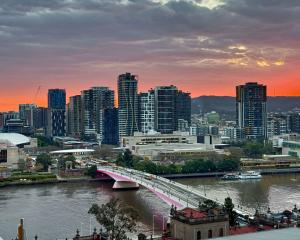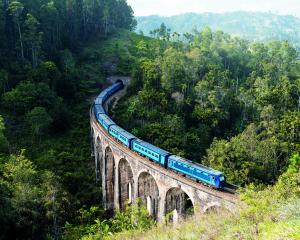It's anyone's guess how many river boats there are but longtime river captains reckon on anything over 200 - and growing.
Kind of river-going stretch limos, they are designed to tuck under low, old bridges.
The bridges, some dating back to Roman days, were never built, of course, to give passage to modern, conventional cruise ships.
Hence the special squat river-boat design.
Inside these strange tubes is four- and five-star luxury.
They are grand hotels that move: you don't.
You unpack once and wake up each day to a new town, a new experience.
Most often, the boats tie up within a few comfortable steps of the town centres.
Our 13-day cruise with Uniworld would take us down the Rhine, the river highway of Europe, and into the more peaceful Moselle.
We would cruise from Amsterdam to Basel, in Switzerland, a distance of 1233km through five countries and 34 locks, the largest of which would raise (or lower) us more than 15m. (Our skipper navigated the locks with precision, like threading a needle - barely a touch.)
The River Queen is a comfortable blend of old-world elegance - timbered public rooms - and modern and spacious cabin comfort.
Cruising at up to about 11kmh, or a fast jog, the boats afford a front-row view of the busy river life.
We didn't need to leave our cabin to watch, through floor-to-ceiling windows, an ever-changing scenery. (Or, if we had wished, we could watch the ship's progress on our TV screen.)
Uniworld has nine such boutique, hotel-style ships each with a maximum capacity of 134 passengers - a very comfortable number at mealtimes or when going ashore on excursions.
They've made some good choices of cities, towns and villages to visit.
There are cathedrals, fairytale castles and historic treasures.
And more cathedrals.
Then there are steep vineyards, great forests, ruins, and medieval villages.
And cathedrals.
While the Rhine is the artery of industry, the Moselle is more like a Sunday drive through the country - villages, farms and vineyards.
On our section of the Moselle alone are 130 small villages, most with houses of grey slate roofs and white walls.
And in every village a church spire peeks above the rooflines.
In late autumn, smoke curls from chimneys and the landscape is painted in colours of brown and gold.
The river bends around banks of wine grapes which cling to hillsides at 70-degree angles, too steep for machinery.
Grapes are being picked.
Along the river banks, dogs are walked and cyclists cycle.
By contrast, the Rhine is more industrial but is also lined with huge, flamboyant castles which leer down from hilltops.
Today, the sun is just a white smudge in the grey clouds and some castles are hiding their splendour.
Trains rush past on the river's edge carrying their passengers and freight, disappearing into a tunnel to reappear moments later.
Many of the towns and villages suffered major damage during World War 2 and have been restored.
So, beware, you are not always seeing an original.
But mostly, it was difficult to tell the restoration from the original.
Our guides, generally, were excellent.
A boon to today's travellers is the introduction of individual radio receivers to hear guides talk.
It means we don't have to cluster around them to hear a commentary.
Our town and village tours were by foot in most cases but in the cities, of course, buses were provided.
Amsterdam is canals, bicycles and beer.
And the Rijksmuseum and Rembrandt's most famous painting, The Night Watch.
Cologne is Cologne Cathedral.
The city has risen from the rubble of 262 air raids in World War 2.
The cathedral was spared.
It is magnificent, the tallest gothic structure in the world.
The earthly remains of the fabled Three Kings of the Magi are said to lie here.
Back on our boat, the Cologne Shanty Choir, formed in 1890, entertains us with some rollicking shanty songs.
Koblenz sits at the junction of the Rhine and the Moselle.
It is a town with a sense of humour: the town symbol is of a boy spitting.
And the clock in one square has a face, rolling eyes and a tongue which pokes out at us on the hour.
There is, of course, a local story behind the clock face.
It's to do with the decapitated head of a villain.
Elsewhere are fun statues and fountains.
We taste federweisser, partly fermented wine and eat delicious onion cake.
It set the trend for wine-tasting throughout our voyage.
The vintages, as would be expected, are excellent - especially the rieslings for which the region is best known.
Cochem in the heart of the Moselle Valley has been producing white wine since Roman times - by law red wine could not be produced, until the 1980s.
We visit nearby Ediger-Eller to be greeted by the village mayor in his ceremonial robes.
This little village, with vineyards right down to the edge of town, gets up to four million visitors every year, attracted by charming half-timbered houses and narrow streets which keep cameras clicking.
We visit winemaker Michael's centuries-old cellar to taste his rieslings.
Very good.
The city of Luxembourg is remarkable for its mix of medieval and modern.
A European Union capital and banking centre, it has an infectious energy.
And so back to the Rhine and Bernkastel, Rudesheim, and Speyer.
We see Strasbourg from a canal boat and then walk through the quaint old town.
Finally, Colmar and its Unterlinden Museum which houses the famous Retable d'Issenheim painting by Matthias Gruenwald.
A word of caution: most of the villages and towns have cobblestoned streets which can be dangerous for unsure feet.
There are often steps to climb and, at least in the autumn, leaves can make pavements slippery.
I'd advise on a reasonable level of fitness for these cruises.
And the ships are not wheelchair friendly.
For the more mobile, the ship provides some bicycles for use in spare time at stops.
And the shopping? Well enough time is allowed for any shopoholic.
Time, too, to wander off on your own.
At day's end, it is great to return to a splendid meal (with complimentary wine) on River Queen, a chat about today's discoveries, and a familiar bed.
The writer travelled courtesy of Uniworld Grand River Cruises and Cathay Pacific Airlines












